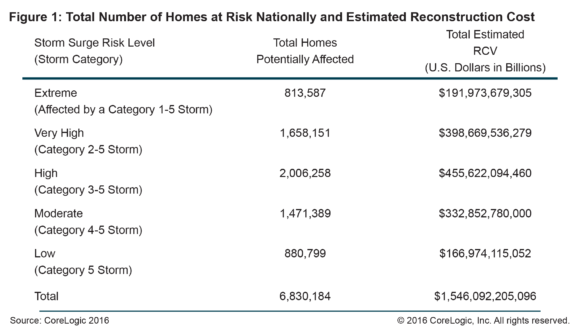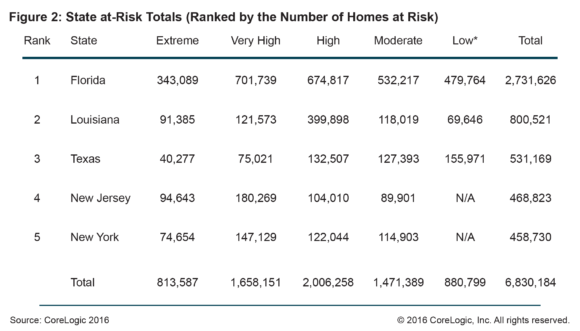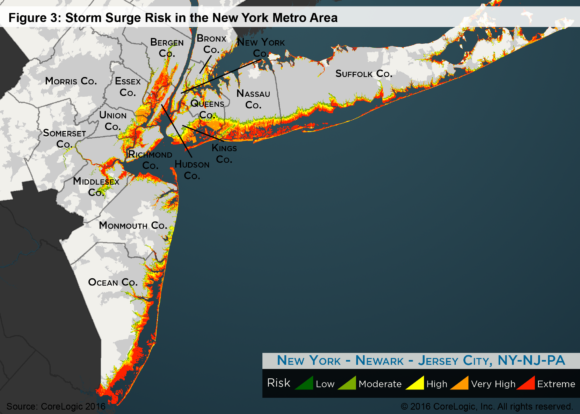This post is part of a series sponsored by CoreLogic.
Total Reconstruction Cost Value is More Than $1.5 Trillion
Current projections for the 2016 hurricane season indicate that an average or slightly greater-than-average number of storms are expected compared with the 30-year average for the Atlantic basin. But as history has demonstrated, it is not only the number of storms that should be of concern, but also the location of the storms.1
The 2016 CoreLogic Storm Surge Report reveals that a total of more than 6.8 million homes located along both the Gulf and Atlantic coasts of the U.S. are at risk of storm surge damage. The estimated total reconstruction cost value (RCV) of these structures is just over $1.5 trillion (Figure 1).

Storm surge risk varies along the coasts, as do changes in bathymetry (the measurement of the depth of water) and land elevation. However, there is no location along these shorelines that is entirely free from the risk of storm surge flooding. Although parts of the southeastern Atlantic coastline and Gulf Coast rank highest in potential damage, lesser surge risk also extends into and includes areas as far north as Massachusetts and Maine.
There is significant variation in the number of homes at risk and the RCV when comparing one state with another. The length of coastline, coastal elevation and density of residential development all contribute to a state’s risk of storm surge flooding. Texas and Florida, which have the longest coastal areas, consistently have more homes at risk than many other states. Florida ranks first with 2.7 million and Texas ranks third with 531,000 (Figure 2).

*The “Low” risk category is based on Category 5 hurricanes which are not likely along the northeastern Atlantic Coast. States in that area have N/A designated for the Low category due to the extremely low probability of a Category 5 storm affecting that area.
The official hurricane season extends from June-November each year, but in no way are storms limited to that time frame. In fact, for 2016, the first hurricane (Alex) has already developed and dissipated. The threat of a storm that may push onshore in a place that is vulnerable to storm surge is ever present, and annual preparation and planning for these types of events will always be necessary.

Sources: The Tropical Meteorology Project – http://hurricane.atmos.colostate.edu/forecasts/
About CoreLogic
CoreLogic (NYSE: CLGX) is a leading global property information, analytics and data-enabled services provider. The company’s combined data from public, contributory and proprietary sources includes over 4.5 billion records spanning more than 50 years, providing detailed coverage of property, mortgages and other encumbrances, consumer credit, tenancy, location, hazard risk and related performance information. The markets CoreLogic serves include real estate and mortgage finance, insurance, capital markets, and the public sector. CoreLogic delivers value to clients through unique data, analytics, workflow technology, advisory and managed services. Clients rely on CoreLogic to help identify and manage growth opportunities, improve performance and mitigate risk. Headquartered in Irvine, Calif., CoreLogic operates in North America, Western Europe and Asia Pacific. For more information, please visit www.corelogic.com.

Topics Catastrophe USA Natural Disasters Windstorm Hurricane Homeowners
Was this article valuable?
Here are more articles you may enjoy.



 Home Insurance at $10,000 a Year Shows California Buyers’ Pain
Home Insurance at $10,000 a Year Shows California Buyers’ Pain  Ryan Specialty Announces Succession Plan: Pat Ryan to Exec Chair, Turner to Be CEO
Ryan Specialty Announces Succession Plan: Pat Ryan to Exec Chair, Turner to Be CEO  Zurich to Buy AIG’s Travel Insurance Business for $600 Million
Zurich to Buy AIG’s Travel Insurance Business for $600 Million  Coverage Needed: Hundreds of Thousands in SE Now in Flood Zones With New Maps
Coverage Needed: Hundreds of Thousands in SE Now in Flood Zones With New Maps 

